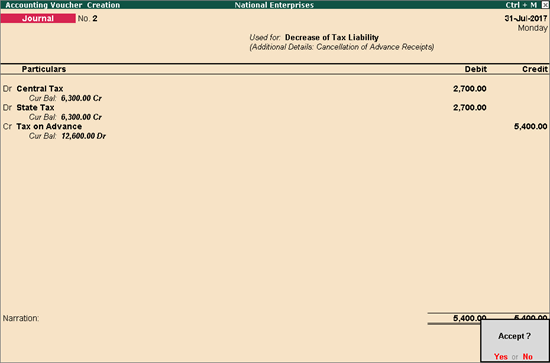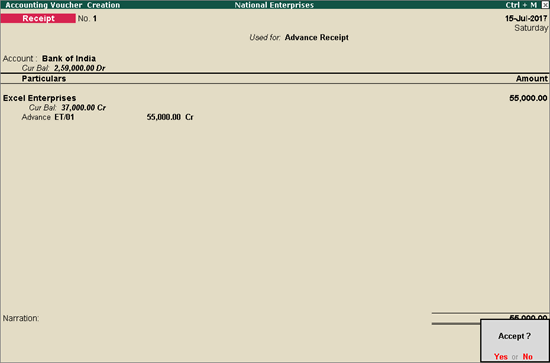
Valid from Release 6.0 to 6.0.2
The advance amount received from customers can be recorded in a receipt voucher. The receipt voucher that is marked as an advance receipt, can be printed with the required GST details.
For any advance received for goods or services, if the corresponding sales invoice is not raised in the same month, the dealer who has received the advance has to pay the GST.
When an invoice is raised against an advance received in a different tax period, the voucher recorded for advance amount received has to be tracked against it.
Advance receipt for orders completed
Same month: Advance receipt > Outward supply > Pay tax
Different month: Advance receipt > Raise tax liability > Pay tax and generate returns > Outward supply in the next month > Reverse tax liability > File returns for the month
Advance receipt for orders cancelled
Same month: Advance receipt > Exclude the advance receipt from GSTR-1 > File returns
Different month: Advance receipt > Raise tax liability > Pay tax for the liability raised > File return > Reverse the tax liability in the next month > Return the advance amount > File returns
To record a receipt voucher for advance receipt from customer exclusive of tax
1. Go to Gateway of Tally > Accounting Vouchers > F6: Receipt.

2. Click V: Advance Receipt to mark the voucher for advance receipt. The values entered in this voucher are captured in GSTR-1 report.
Note: Receipt vouchers recorded without clicking V: Advance Receipt will not have GST implications, and will form part of the Summary of Excluded Vouchers.
3. Account: Select the bank to which the payment will be made.
4. Select the party ledger enabled for bill-wise details.
5. In the Advance Receipt Details screen, select the Stock Item (goods enabled for GST) or Ledger Name (services enabled for GST). Based on the GST rates defined in the stock item or ledger, the breakup of GST rate for Central Tax, State Tax and Cess is displayed.
6. Enter the advance received in the Amount column. You can adjust this against the sales invoice partially/fully, based on the sale value. At the end of the month, depending on the balance amount of advance available, you can record a journal voucher to raise the liability.
Based on the amount entered, the breakup of GST amount gets auto calculated for Central Tax, State Tax and Cess, if applicable. The Advance Receipt Details screen appears as shown below:

Note: The central and state tax rates shown in the above screen, are captured in the GSTR-1 report.
7. Press Ctrl+A to accept the Advance Receipt Details screen and return to receipt voucher.
8. Select the type of reference as Advance and enter the reference details in the Bill-wise Details screen.
9. If the amount is received through bank, select the Transaction Type and enter the required details in the Bank Allocations screen.
10. Press Enter to save.
11. Click P: Print and enable the option Print Advance Receipt to Yes to print the invoice.
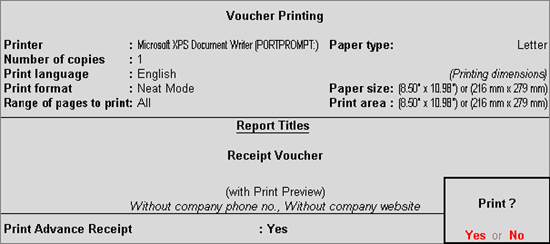
The printed receipt voucher with the GST details appears as shown below:

The GSTR-1 report displays the tax liability on advance receipts as shown below:
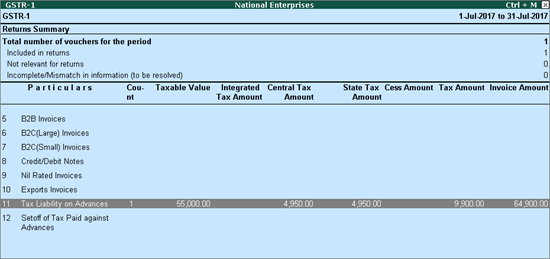
The advance receipt voucher count appears in the Included in returns row.
When the sales invoice is recorded in the same month, the receipt voucher has to be linked to it by selecting the Type of Ref as Agst Ref in the Bill-wise Details screen of sales invoice.
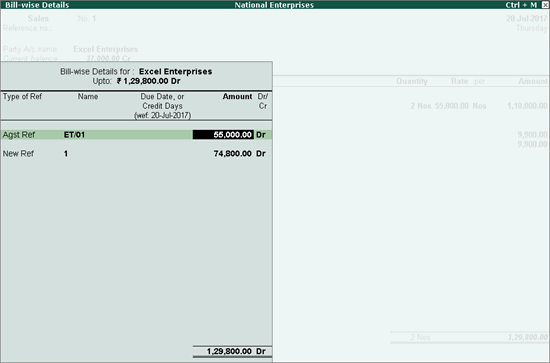
As the sales invoice is recorded in the same month, the GSTR-1 report displays only the sales invoice as shown below:

The advance receipt voucher appears as part of transactions Not relevant for returns and is categorised as No GST Implications in the Summary of Excluded Vouchers report.
Record a receipt voucher in the month of July as shown below:
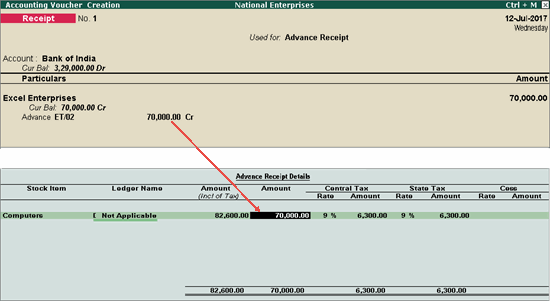
At the end of the month, record a journal voucher to raise the liability to pay tax as shown below:
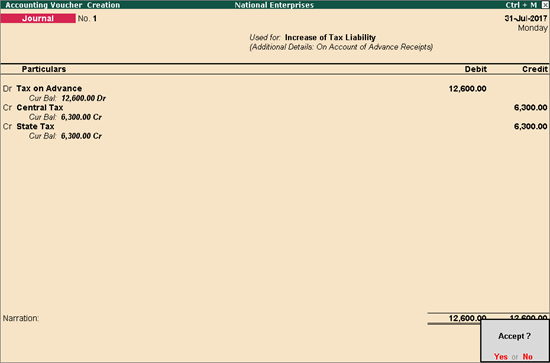
The journal voucher that is recorded does not have any impact on the GSTR-1 report.
Record a sales invoice in the month of August as shown below:
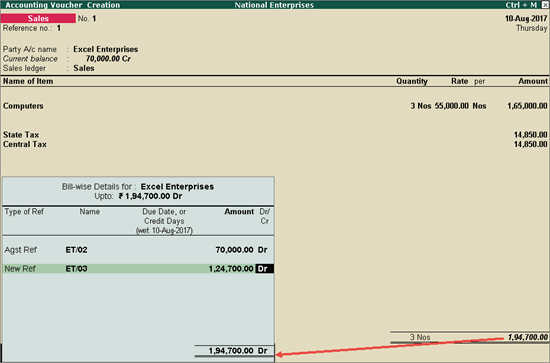
You can record advance receipt inclusive of tax in a receipt voucher.
1. In the receipt voucher, click V: Advance Receipt, select the bank/cash account, and the party ledger enabled for bill-wise details.

2. In the Advance Receipt Details screen, enter the Amount (Incl of Tax). The Amount available for setoff against sales invoice and the taxes included in the advance amount appears as shown below:

3. In the advance receipt voucher, select the GST ledgers. The tax amount appears automatically.
4. Accept the voucher.
This voucher can be linked to sales invoice by adjusting only 55000 in the Bill-wise Details screen. Based on the amount offset against sales invoice, you need to reverse the tax deducted in the receipt voucher by selecting the GST ledgers using a journal voucher.
After recording the sales invoice, you need to reverse:
● The tax liability raised in journal voucher for the advance receipt of the previous month.
● The tax liability raised in the advance receipt voucher of the current/previous month.
To reverse the tax liability, record a journal voucher by debiting the GST ledgers and crediting the expense ledger or ledger grouped under Current Assets, as shown below:

If an advance receipt voucher is recorded,a journal voucher is recorded to raise the tax liability, and then the transaction is cancelled:
● Exclude the advance receipt voucher from the GSTR-1 report.
● Record a journal voucher to reverse the tax liability to the extent to which the transaction is cancelled.
If an advance receipt voucher is recorded, a journal voucher is recorded to raise liability, and then the transaction is cancelled in the next tax period:
● Record a journal voucher to reverse the tax liability to the extent to which the transaction is cancelled.
1. Go to Gateway of Tally > Display > Statutory Reports > GST > GSTR-1.
2. Select Included in returns and press Enter.
3. Select Advance Receipt and press Enter.
4. Select the receipt voucher and click X: Exclude Vouchers.
5. Click Yes for the message Do you want to exclude this voucher?.
To reverse the liability on cancellation of a transaction
1. Click J: Stat Adjustment in GSTR-1 report or from the Accounting Vouchers > F7: Journal.
2. Select the options as shown below:

3. Debit the GST ledgers and credit the ledger grouped under Current Assets as shown below:
